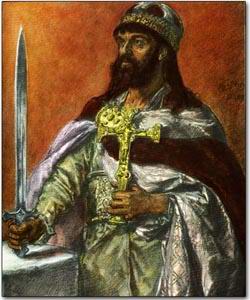960
Appearance
This articleneeds additional citations forverification.(November 2017) |
| Millennium: | 1st millennium |
|---|---|
| Centuries: | |
| Decades: | |
| Years: |
| 960 by topic |
|---|
| Leaders |
| Categories |
| Gregorian calendar | 960 CMLX |
| Ab urbe condita | 1713 |
| Armenian calendar | 409 ԹՎ ՆԹ |
| Assyrian calendar | 5710 |
| Balinese saka calendar | 881–882 |
| Bengali calendar | 367 |
| Berber calendar | 1910 |
| Buddhist calendar | 1504 |
| Burmese calendar | 322 |
| Byzantine calendar | 6468–6469 |
| Chinese calendar | Mình chưaNăm (EarthGoat) 3657 or 3450 — to — Canh Thân năm (MetalMonkey) 3658 or 3451 |
| Coptic calendar | 676–677 |
| Discordian calendar | 2126 |
| Ethiopian calendar | 952–953 |
| Hebrew calendar | 4720–4721 |
| Hindu calendars | |
| -Vikram Samvat | 1016–1017 |
| -Shaka Samvat | 881–882 |
| -Kali Yuga | 4060–4061 |
| Holocene calendar | 10960 |
| Iranian calendar | 338–339 |
| Islamic calendar | 348–349 |
| Japanese calendar | Tentoku4 ( thiên đức 4 năm ) |
| Javanese calendar | 860–861 |
| Julian calendar | 960 CMLX |
| Korean calendar | 3293 |
| Minguo calendar | 952 beforeROC Dân trước 952 năm |
| Nanakshahi calendar | −508 |
| Seleucid era | 1271/1272AG |
| Thai solar calendar | 1502–1503 |
| Tibetan calendar | Âm thổ dương năm (female Earth-Goat) 1086 or 705 or −67 — to — Dương kim năm con khỉ (male Iron-Monkey) 1087 or 706 or −66 |

Year960(CMLX) was aleap year starting on Sunday(link will display the full calendar) of theJulian calendar.It was the 960th year of the Common Era (CE) and Anno Domini (AD) designations, the 960th year of the first millennium, the 60th year of the 10th century, and the first year of the 960s decade.
Events
[edit]By place
[edit]Byzantine Empire
[edit]- Summer –Siege of Chandax:AByzantinefleet with an expeditionary force (comprising about 50,000 men) underNikephoros Phokaslands onCrete.Nikephoros defeats the Muslim resistance and begins asiegeat the capital ofChandax.He decides toblockadethe city for the winter, while his engineers begin to constructsiege engines.[1]EmirAbd al-Aziz ibn Shu'aybsends for aid by theFatimidsinIfriqiyaand theCaliphate of Córdoba(modernSpain).
- November 8–Battle of Andrassos:The Byzantines underLeo Phokas the Youngerdefeat theHamdanidarmy (30,000 men) in anambushin the passages of theCilicianmountains, in southAsia Minor(modern-dayTurkey). EmirSayf al-Dawlabarely manages to escape, and returns toAleppowith only 300 horsemen. The Hamdanids can no longer afford to raid inAnatolia,which is a turning point in theArab-Byzantine warsin the East.
Europe
[edit]- Mieszko I,a duke of thePiast Dynasty,becomes prince (de factoruler) ofPolandon the death of his fatherSiemomysł.Mieszko continues to subdue the neighbouring tribes under his control. Two obstacles to this plan are theWestern Slavtribal group, theVeleti(also known as theWilzior "Wolf people" ) who are raiding Mieszko's lands for plunder; and theSaxonborder dukes, who are pushing eastwards in search of new lands to conquer.[2]
- Harald Bluetooth,king ofDenmark,consolidates his rule overJutlandandZealand.He adoptsChristianity,erecting acarved stoneatJellingto honour his parents. It features a runic inscription (best-known in Denmark) and an image ofChristsurrounded by interlace. The otherScandinaviankingdoms slowly convert to Christianity (approximate date).
- June/July –Adalbert II,co-ruler and the son of KingBerengar II,with the support of DukeHugh of Tuscany,invades thePapal StatesunderPope John XII.WithLombardforces closing in onRome,a papal delegation is sent to KingOtto I(the Great) to appeal for assistance.
- Autumn –Oberto I,margrave of theObertenghifamily, takes refuge inGermany.He travels with influential Italian leaders to the Saxon court of Otto I to intervene inItalyto protect him from Berengar II.
- Richard I(the Fearless), duke ofNormandy,marriesEmma of Paris.She is the daughter ofHugh the Great,formerDuke of the Franks.The union gives him a permanent status to theHouse of Capet.
England
[edit]- Dunstanreceives thepalliumas archbishop ofCanterburyfrom Pope John XII. He reforms monasteries and enforces the rule ofSaint Benedict:poverty,chastity and obediencefor monks.
Africa
[edit]- TheKingdom of Aksum(modernEritrea) is destroyed byBeta Israelinvaders, under the leadership of QueenGudit(approximate date).
Asia
[edit]- February 4– TheSong Dynastyis established atKaifengby the 33-year-old military leaderZhao Kuangyin.He begins to unify the empire by conquering other lands and becomes the first emperor, called asTaizu of Song.The Song Dynasty will rule northernChinafor over 300 years (until1279).
By topic
[edit]Religion
[edit]- Dunstan founds theChurch of St. DunstaninEast Sussex.
Births
[edit]- Abu Nasr Mansur,Persianmathematician(approximate date)
- Aimoin,French monk andchronicler(approximate date)
- Arnulf II(the Younger), Frankishnobleman(or961)
- Bagrat III,king ofAbkhazia(Georgia) (d.1014)
- Bernward,bishop ofHildesheim(approximate date)
- Constantine VIII,Byzantine emperor (d.1028)
- Eckard I,German nobleman (approximate date)
- Fan Kuan,Chineselandscape painter(approximate date)
- Gershom ben Judah,Germanrabbi(approximate date)
- Gormflaith ingen Murchada,Irish queen (d.1030)
- Gotthard,bishop of Hildesheim (d.1038)
- Hugh III,French nobleman (approximate date)
- Indra Pala,king ofKamarupa(India) (d.990)
- Li,empress consort of theSong Dynasty(d.1004)
- Mazu,Chinese fisherman's daughter and worshipped asTaoistgoddess (approximate date)
- Sharaf al-Dawla,BuyidemirofKermanandFars(approximate date)
- Sigurd the Stout,Viking nobleman (earl) (approximate date)
- Sweyn Forkbeard,king ofDenmarkandEngland(d. 1014)
- Xu You,official and court minister ofSouthern Tang
Deaths
[edit]- May 31–Fujiwara no Morosuke,Japanese statesman (b.909)
- June 15–Eadburh of Winchester,English princess and saint
- June 23–Feng Yanji,chancellor of Southern Tang (b.903)
- August 12–Li Gu,chancellor ofLater Zhou(b. 903)
- Ælfric,bishop ofHereford(approximate date)
- Adele of Vermandois,Frankish noblewoman
- Arnold I of Astarac,Frankish nobleman
- Bernard the Dane,Viking nobleman (approximate date)
- Časlav,prince ofSerbia(approximate date)
- Emmanuel I,patriarch of theChurch of the East
- Fulk II(the Good), Frankish nobleman
- Gao Baorong,king ofNanping(Ten Kingdoms) (b.920)
- George II,king of Abkhazia (Georgia)
- Gopala II,ruler of thePala Empire(India)
- Guan Tong,Chineselandscape painter
- Justan I ibn Marzuban,Sallarid ruler
- Lhachen Dpalgyimgon,king ofMauyul(Tibet)
- Murchadh mac Aodha,king ofUí Maine(Ireland)
- Ratna Pala,king of Kamarupa (India) (b. 920)
- Siemomysł,duke of thePiast Dynasty(Poland)
- William Garés,Frankish nobleman
- Yelü Lihu,prince of theKhitan Empire(b.911)
References
[edit]- ^Romane, Julian (2015).Byzantium Triumphant.Barnsley: Pen and Sword Books. p. 5.ISBN978-1473845701.
- ^Richard Brzezinski (1998). History of Poland:Old Poland, King Mieszko I,p. 14.ISBN83-7212-019-6.
